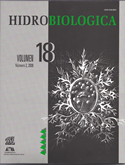Spatial variation of biomass of seaweed assemblages in the temperate-tropical transition zone of Baja California Peninsula, Mexico
Palabras clave:
Biomasa, Zona de transición, Gelidium, Macrocystis, fisiografía.Resumen
Se analizaron los cambios en la biomasa de las asociaciones de macroalgas en una zona de transición templadotropical entre octubre de 1996 y agosto de 1997 en cuatro localidades. Las localidades con la temperatura más baja, alto índice de surgencias y mayor dominancia de sustrato duro presentaron los mayores valores de biomasa de macroalgas (El Cardoncito (7.2 kg m-2) y Las Boyitas (6.2 kg m-2)) y la mayor cantidad de especies de afinidad templada. Por el contrario El Datilito (0.366 kg m-2) en donde la temperatura fue más alta, no hay evidencia de surgencias, el sustrato es arenoso, es un área más somera y protegida, presentó el menor valor de biomasa de macroalgas y la menor proporción de algas de afinidad templada. Los análisis de componentes principales y similaridad mostraron una estrecha relación entre El Cardoncito y Las Boyitas. El Datilito se mantuvo como una localidad independiente, mientras que Chester Rock (4.3 kg m-2) tuvo características intermedias de biomasa de algas. La estrecha relación entre las dos primeras localidades puede explicarse por la similaridad en términos de su alta biomasa aunado con las características fisiográficas y ambientales que presentaron. El Datilito presentó características fisiográficas y ambientales muy diferentes a las demás localidades, además de tener muy poca biomasa de macroalgas.Descargas
Descargas
Publicado
Cómo citar
Número
Sección
Licencia
Los autores/as que publiquen en esta revista aceptan las siguientes condiciones:
De acuerdo con la legislación de derechos de autor, HIDROBIOLÓGICA reconoce y respeta el derecho moral de los autores, así como la titularidad del derecho patrimonial, el cual será cedido a la revista para su difusión en acceso abierto.
Publicar en la revista HIDROBIOLÓGICA tiene un costo de recuperación de $500 pesos mexicanos por página en blanco y negro (aproximadamente 29 dólares americanos) y $1000 pesos por página a color (aproximadamente 58 dólares americanos).
Todos los textos publicados por HIDROBIOLÓGICA sin excepción se distribuyen amparados bajo la licencia Creative Commons 4.0Atribución-No Comercial (CC BY-NC 4.0 Internacional), que permite a terceros utilizar lo publicado siempre que mencionen la autoría del trabajo y a la primera publicación en esta revista.
Los autores/as pueden realizar otros acuerdos contractuales independientes y adicionales para la distribución no exclusiva de la versión del artículo publicado en HIDROBIOLÓGICA (por ejemplo incluirlo en un repositorio institucional o publicarlo en un libro) siempre que indiquen claramente que el trabajo se publicó por primera vez en HIDROBIOLÓGICA.
Para todo lo anterior, el o los autor(es) deben remitir el formato de Carta-Cesión de la Propiedad de los Derechos de la primera publicación debidamente requisitado y firmado por el autor(es). Este formato se puede enviar por correo electrónico en archivo pdf al correo: enlacerebvistahidrobiológica@gmail.com; rehb@xanum.uam.mx (Carta-Cesión de Propiedad de Derechos de Autor).
Esta obra está bajo una licencia de Creative Commons Reconocimiento-No Comercial 4.0 Internacional.


